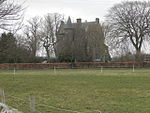Liff, Angus

Liff is a village in Angus, Scotland, situated 4+1⁄2 miles (7 kilometres) west-northwest of Dundee on a south-facing slope two miles (three kilometres) north of the River Tay. It had a population of 568 in 2011. Surrounded by farmland, it has been described as 'haunted by wood pigeons and the scent of wild garlic' and having a 'wonderful view over the firth [of Tay]'. One-half mile (800 metres) east lies the site of the former Royal Dundee Liff Hospital, now given over to private housing. Further east lie Camperdown House and Park. One-half mile (800 metres) south is House of Gray, a large eighteenth-century mansion house in the neoclassical style, currently standing empty. The village contains twelve listed buildings, with others nearby. For several centuries the name Liff denoted a large area, not a village. It comprised the parish of Liff together with its united parishes of Benvie, Invergowrie, Logie, and Lochee, and so included substantial parts of the city of Dundee. The village around the church was known as Kirkton of Liff or simply the Kirkton.An ancient site in the village called Hurly Hawkin was regarded for several centuries as a palace of King Alexander I.The placename features in the title of a bestselling book by Douglas Adams and John Lloyd, The Meaning of Liff. It is defined there as 'a book, the contents of which are totally belied by its cover'.
Excerpt from the Wikipedia article Liff, Angus (License: CC BY-SA 3.0, Authors, Images).Liff, Angus
Fowlis Road,
Geographical coordinates (GPS) Address Nearby Places Show on map
Geographical coordinates (GPS)
| Latitude | Longitude |
|---|---|
| N 56.485243 ° | E -3.086291 ° |
Address
Fowlis Road
Fowlis Road
DD2 5PL
Scotland, United Kingdom
Open on Google Maps








